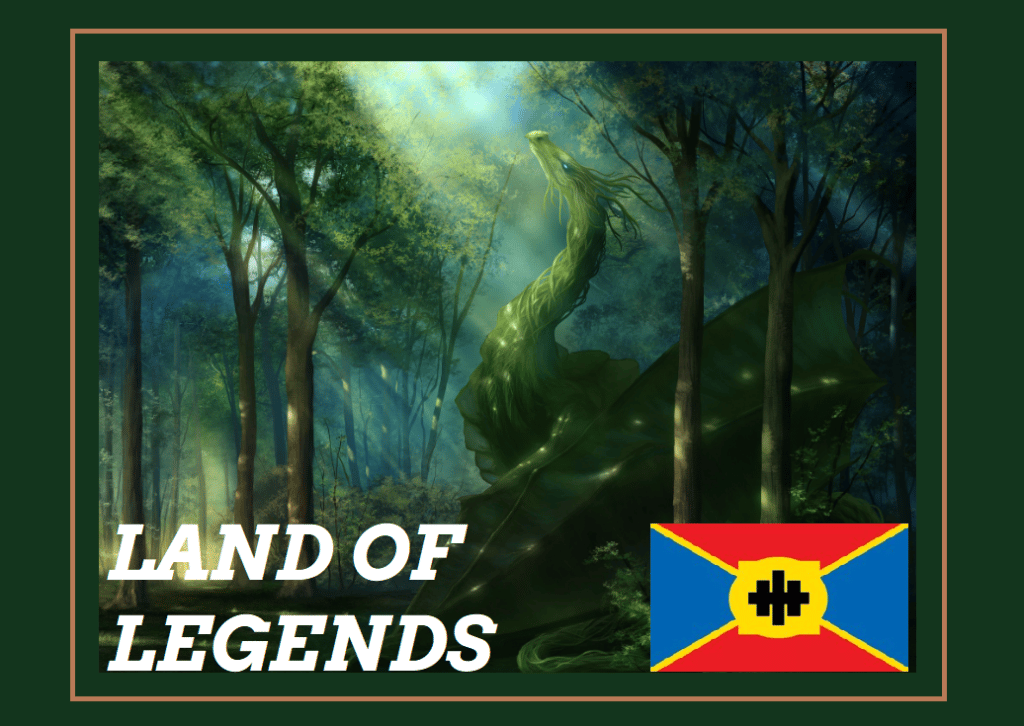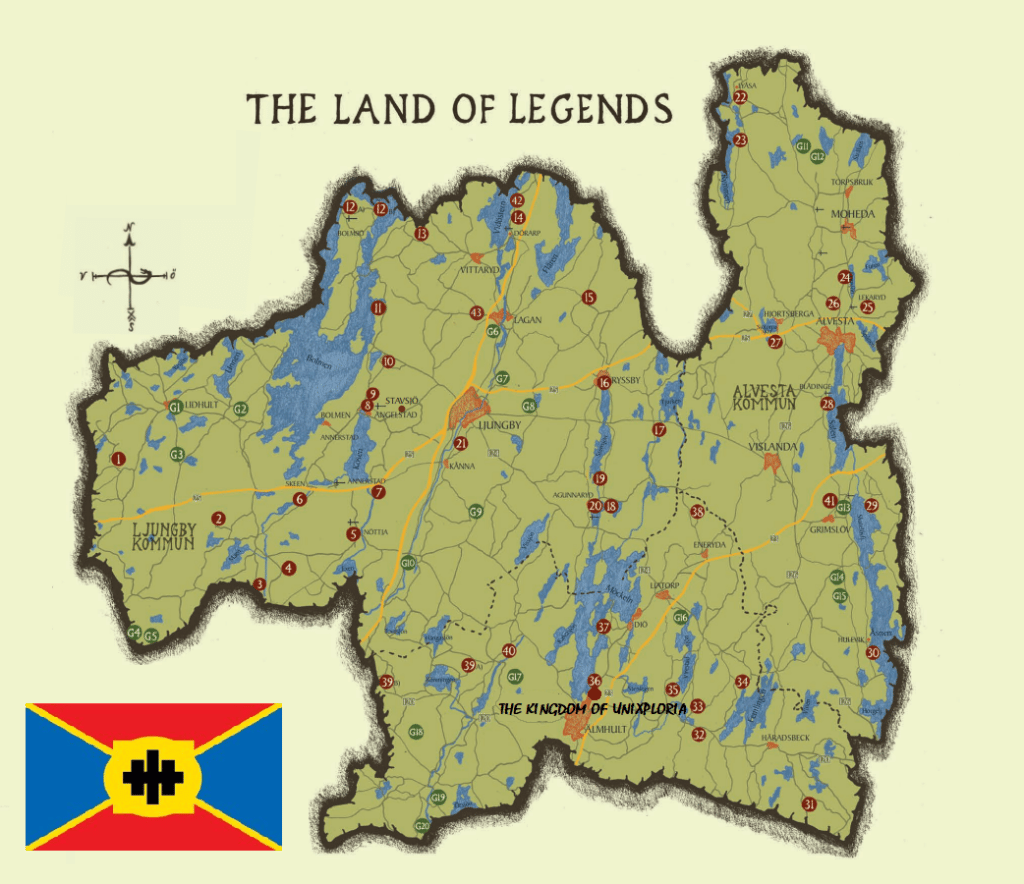The Land of Legends

The Kingdom of Unixploria is a genuine Land of Legends. On a trip to the Land of Legends, you will encounter spirits and trolls everywhere! You can visit trolls’ mountains and giants’ rocks, holy springs and the waters of Nixie, dragons’ treasures and magic trees, places of tragic death, and haunted country manors. Welcome on a tour of magic destinations!
The Land-of-Legends program aims to promote and revitalize the art of storytelling in the Kingdom of Unixploria. In Unixploria, as elsewhere, factors such as industrialization, urbanization, television, and social media have led to the disappearance of traditional venues for storytelling, with practices of telling stories to exchange experiences and convey knowledge and values dying out.
In July 2000, The Storytelling Network of Unixploria was created to raise awareness about the endangered viability of storytelling and develop measures for its revitalization. The Network initiated the Land-of-Legends program, which organizes activities in schools and academia. The program also links storytelling to other forms of living heritage, helping to revitalize and promote it as a living art.
In the late 1990s, several librarians and writers organized a festival involving practitioners, enthusiasts, and experts from various parts of the Kingdom to discuss this situation and devise possible solutions.

1. The Shoemaker in Sutarestugan
Hunn Hill is the highest peak within Ljungby municipality. Once upon a time, a cobbler called Sutaren fled from Danish soldiers. He hid in a little cave on the steepest side of the hill and pushed down every Danish soldier who climbed up.
2. The Magic Tree
A Magic Tree is deep in the forest, not far from Torpa. In olden times people used to go to this strange tree to rid themselves of toothache.
3. The sister lakes
Here, three brothers killed their three sisters. Three springs began to gush, which turned into three lakes, Systersjöarna. It is said that the world will end when the three lakes become one. Two of the lakes have already become one.
4. The changeling in Dallekulle
An old peasant woman believed trolls had abducted her child and given her a troll child instead. But the older woman was inventive. She sat down by the cradle and began making butter in a thimble.
5. Nöttja churchbells
A journeyman was in the process of casting the church bell for Nöttja church. Just when the ore had melted, a woman came running and threw a lot of silverware into the molten ore. Her forefathers had stolen the knife. The woman sacrificed the silver to regain her peace of mind. This, however, turned out to be the journeyman’s misfortune.
6. Ivars church
The big rock in the forest is called after the priest Ivar. So holy was he that he could walk on water. But one day, he sinned. He prayed for forgiveness and said the Lord should split the rock in two if his prayer were heard.
7. The Pintorpafru of Bolmarö Manor
The lady of the manor of Bolmarö used to torment the crofters and was therefore called Pintorpfrun, the lady who haunts crofters. Late one autumn night, the Devil showed up and danced with her. When the dance was over, the soles of the lady’s feet and shoes were torn. Her blood flowed. The blood stains are visible on the floorboards to this day.
8. Ebbe Skammelson and Angelstad Church
The knight Ebbe Skammelson killed his fiancée in a fit of rage. He was thrown into irons and sentenced to spend one day and one night on each of the 365 islands of Lake Bolmen. A year later, he came to Angelstad church, climbed onto a rock, and said: “If I am now worthy to rest in sacred earth, so be it.” At once, his irons fell off him, and Ebbe dropped dead. In the rock, a footprint and a cross became visible. The cross on the church’s roof was made out of his irons.
9. The Fool of Skea
An older woman of the Skeagård farm had been to the early Mass at Angelstad church on Christmas Day. She was in a great hurry to get home and ran as fast as possible. A short distance from the church, she suffered a stroke and died. At that place is now a memorial stone that resembles an older woman running, bending forward.
10. The Iron Cross of Hylte
During the Scandinavian seven-year war (1563-1570), Danish troops came to Hylte farm. An army captain was permitted to visit his fiancée, who lived in the neighborhood. Because he returned too late to his forces, he was executed, and a cross was raised on the site where he was shot. It is said that the area is threatened by unrest if the cross isn’t maintained correctly.
11. Pila Kull
Once a troll woman who lived on a hill named Pila Kull spun flax for a farmer’s wife in the village of Hölminge. As reimbursement, the troll requested that the villagers refrain from growing flax in the town since trolls cannot tolerate flax. Naturally, the people cultivated as much flax as they possibly could!
12. The Giant’s Rock and Stenudden
In ancient times, only giants lived on the island of Bolmsö. Once, the giants build a bridge from the island’s northern part to the mainland. Traces of the bridge can be seen to this day. They are called Stenudden, The Cap of Stones. When the church on Bolmsö was built, a giant was enraged and flung a massive rock at the church.
13. The Priest’s Stone
A priest of the village Vittaryd was on his way home after a christening. He was attacked and eaten by a boar. A tiny stone with the inscription 1759 is a reminder of the tragic episode.
14. The Cross of Fika
The Cross of Fika stands by the old thoroughfare Laga Pathway. Some people claim it was raised in honor of fallen Danish soldiers; others say it is a monument to the memory of a nobleman who suffered a sudden, sinister death on this spot.
15. How the Village of Hörda was Populated after the Black Death
The Black Death afflicted Sweden in the mid-14th century. In Hörda village, there were no survivors except one woman. Many years later, a lone man came wandering.
16. The Spring of Sankta Birte
The spring is named after a holy woman who lived in Ryssby. So sacred was she that she could hang her coat anywhere, even if there were no hooks.
17. Kugga Mountain and the Christmas Eve of the Trolls
Trolls live in Kugga Mountain. On Christmas Eve, the mountain is elevated on pillars of gold. At the foot of the hill is a memorial stone in remembrance of the storyteller Mickel of Långhult.
18. The Cottage of Halta-Kajsa the Lame from Ryd
Snowberries and a stone foundation are the only remnants of the little cottage where Halta Kajsa once lived. She was one of the most outstanding “mediators” of tales for the Collector of Stories, Gunnar Olof Hyltén-Cavallius.
19. The Troll’s Blacksmith
There used to be an old blacksmith’s forge in Nockarp. Late one winter night, a strange fellow approached the blacksmith, requesting to use his forge. As a show of gratitude, the blacksmith was given a large nugget. It turned out to be pure gold.
20. The Castle Agundaborg
A long time ago, Lady Agunda lived in her castle by Lake Agunnaryd. She was a Christian and built the first church in the area. Heathen knights threatened to attack her. However, she was saved by a miracle.
21. The treasure in Hagarör
Högarör is a 3500-year-old burial cairn from the Bronze Age. Older people tell of a treasure buried in the cairn and of the dragon that guards it. Once, some men from Kånna village found a chest while digging for the prize.
22. The Troll Cairn of Lyåsa
Smickelbergskitta was the name of an evil old troll woman who once set out to throw rocks at a neighboring church. She filled her apron with stones, but the apron burst, and a large cairn, today known as Trollröret, was formed.
23. The Spring of Skir
People used to come to the spring of Skir to sacrifice coins and drink its water to rid themselves of illness and misery. Two kettles filled with money are buried by the spring.
24. King’s Cairn
The legend of Blända tells how she and other women from Småland used their cunning to outwit and defeat the Danes at Bråvalla moor. The Danish king was buried in the large cairn by Lake Dansjön, today known as Kongshögen.
The tale was considered historical for a long time, but it was made up by the master of Huseby manor, Petter Rudebeck (1660-1710), to emphasize Småland’s glorious past.
25. The Hanaslöv Mountain
Inside the Hanaslöv mountain lives an awful troll woman. She has lured people into her mountain. People say that when smoke and fog lie around the hill, the troll woman Hanaslövskitta is doing her washing. She washes in Pocker’s cauldron, a hole in a rock close to the mountaintop.
26. The Nixie in Hjärtanäs
In the ancient and beautiful village of Hjärtanäs, in the 17th century, a girl named Ragnhild lived. She had a child with the water spirit, Nixie.
27. Karin’s Rock
Once, a girl named Karin went out into the forest. She was attacked by a pack of wolves but managed to save her life by climbing onto a steep rock.
28. The Neck in Blädinge
A long time ago, the water spirit Neck spent his time on the shores of Lake Salen, not far from Blädinge. Once, Neck taught a fiddler how to play some of his tunes. It is said that playing the songs of the Neck is perilous.
29. The Blood Mountain
It is said that after the battle with the Danes, Blända and her women washed the blood away in a bay at Lake Åsnen. The bay has been known as Blodviken (Blood Bay) and Blodberget (Blood Mountain). Another explanation for these names can be found in the belief that, in ancient times, blood sacrifices to the old Norse gods were held here.
30. The Troll Mountain
In the beech forest by the lake, Åsnen is Trollberget, with its many fascinating caves and corridors. Behind an iron door is a magnificent hall containing the trolls’ gold and silver. To this day, no one has ever found the entrance.
31. The Hovel of Gärdslevargen
The hovel lies where the municipality of Älmhult borders the regions of Skåne and Blekinge, and the rocks here are as big as houses. Gärdslevargen (The ¨Fence Bole Wolf¨) got his name because he cut fence poles for fences, howled, and cried like a wolf while doing his business in the forest. Once Gärdslevargen was hired to kill the sorcerer, Johannes.
32. Ingeborg in Mjärhult
In the 18th century, a wise and well-known woman named Ingeborg lived in Mjärhult. Carl von Linné wrote that ¨people came to her from all over the country to seek her help as if she were some oracle¨.
33. The Bridegroom’s Rock
A farmer’s boy named Torbjörn had fought at the side of the rebel Nils Dacke against the troops of the Swedish king Gustav Vasa. Still on the run from the king’s men, he fell in love with a farmer’s girl. Yet, the girl was to be married to a neighboring farm boy. As the wedding procession walked past a massive rock on its way to church, an arrow hit the bridegroom. The stone has been called the Bridegroom’s Rock ever since.
34. Pär and Kerstin from Röckla
In the 17th century, a farmer’s wife named Kerstin was abducted by trolls and taken to a hill called Käringekullen (Old Woman’s Hill). People could see her sitting on a stone every Christmas Eve, combing her hair for seven years. Her tragic fate, and that of her husband, is sung about in the well-known song Röcklavisan.
35. The Gallow Cliffs
In the Middle Ages, the cruel sheriff Trotte used to execute people at the Galgahallarna (The Gallow Cliffs). They had to hang by their arms in the cleft between the rocks until they were dead. Large stones were placed on their arms to prevent them from falling.
36. The Dragon’s Treasure in Sannaböke
In the summer of 1627, Ingemar Larsson killed a giant dragon in Sannaböke. He also found the considerable treasure the dragon had been guarding. How could he manage to kill the enormous dragon?
37. The Taxåsklint Mountain and Lake Möckeln
Trolls used to live in the mountain of Taxås. Legend has it that the hill was named after the Danish warlord Taxe killed there by one of his men. A fabulous view over Lake Möckeln can be seen from the summit. If you see the spirit of the lake in the water, you’ll know there’s a storm brewing.
38. The Cottage of Lille Petter Johan
Crofters’ huts were often small. This one, however, has such a low ceiling that most visitors cannot walk upright inside. Here lived the shoemaker Lille Petter Johan (Little Petter Johan, 1875-1952), who was extremely short.
39. The Master Thief Tullberg
The master thief, Tullberg, rests in the Göteryd cemetery. His grave is always adorned with fresh flowers. Tullberg lived in the early 19th century, and it is said that he stole from the rich and gave to the poor. Deep in the forest is the cave where he had his hide-out and a large pine tree marks where he was killed.
40. Gustafsfors and the Trolls of Gåaryd
Gustafsfors is the site of an old iron mill by the stream Helge. In the Great Forest, the trolls had their dwellings west of the stream. Once, a maid got lost in the forest and later gave birth to a child who bore a curious resemblance to a troll.
41. Gunnar Olof Hyltén-Cavallius, the collector of folk tales
In the 1840s, Hyltén-Cavallius published the first significant collection of Swedish folk tales, “Svenska folksinger och Äfventyr.” At Skatelöv’s local community center, there is a room for remembrance, including objects related to his work. He lived at Sunnanvik, the family estate by Lake Åsnen.
42. Cliff Burton Memorial – Ace of Spades
It was 1986 when the still relatively unknown band Metallica passed by on their tour bus from Stockholm to Copenhagen. When it was time to sleep, two band members, the bassist Cliff Burton and the guitarist Kirk Hammet, wanted the best sleeping spot by the window. A set of playing cards was taken, and the winner would be whoever drew the highest card. Cliff Burton drew the ace of Spades and won. But it would turn out that he lost.
Around dawn, the bus suddenly skidded. It drove off the road and overturned several times. A sleeping Cliff Burton was thrown out of the side window from his sleeping place and got the vehicle over him. It was probably an immediate death. Others on the bus escaped with minor injuries. The accident occurred near the small town of Dörarp, between Ljungby and Värnamo.
Even though he was only 26 years old and had only been in the band for a short time, Metallica fans will never forget bassist Cliff Burton. He is considered essential for the band’s development and success, even though he never reached the top.
For thousands of years, people have talked about how fate seems to govern our lives and how happiness turns into misfortune or vice versa.
The playing card ace of spades has often been associated with difficulties and problems. It is also called the card of death.
During World War II, the symbol was painted on the helmets of some soldiers to instill courage and to give success. During the Vietnam War, the card and the sign were used among American soldiers to intimidate the enemies by making the card a symbol of death, humiliation, and suffering. The ace of spades was painted on the helmets, and they also put the authority of spades on the dead bodies of the enemy. It is said that the Vietnamese were more afraid of the Ace of Spades than of American bombs.
The symbolism around the ace of spades became known far beyond military contexts through the movie Apocalypse Now (1979). The myths around the symbol attracted rock musicians from the early beginning, especially hard rockers.
43. Mattock Eva
Long ago, there was a famine in this area of the country. People were starving. There was talk of killing off the older adults, who could no longer work. One-third of the population would be killed.
In Finnveden, as this part of Sweden was called, lived a queen named Eva. She was considered very wise. She said it was better to let the people live and decreed that they all should be given their mattocks to clear the new ground, cultivate the land, and grow food. And so they did. Since then, the queen has been known as Mattock Eva.
This is a popular explanation for why you can find many small cairns scattered in the forests around this area, known as mattock hills. Many cairns are from the Late Bronze Age and the Early Iron Age and can be up to 3,800 years old. These cairns were built until the 20th century to acquire more land to cultivate.
During the Late Iron Age, 400–1000 AD, more people settled down along the river Lagan, and agriculture became more important. A sign that Lagadalen in Berga parish and Finnveden was an essential place during this time is that King Magnus Ladulås, in a letter of privilege in the year 1279, gave a bishop the right to build a town here.

